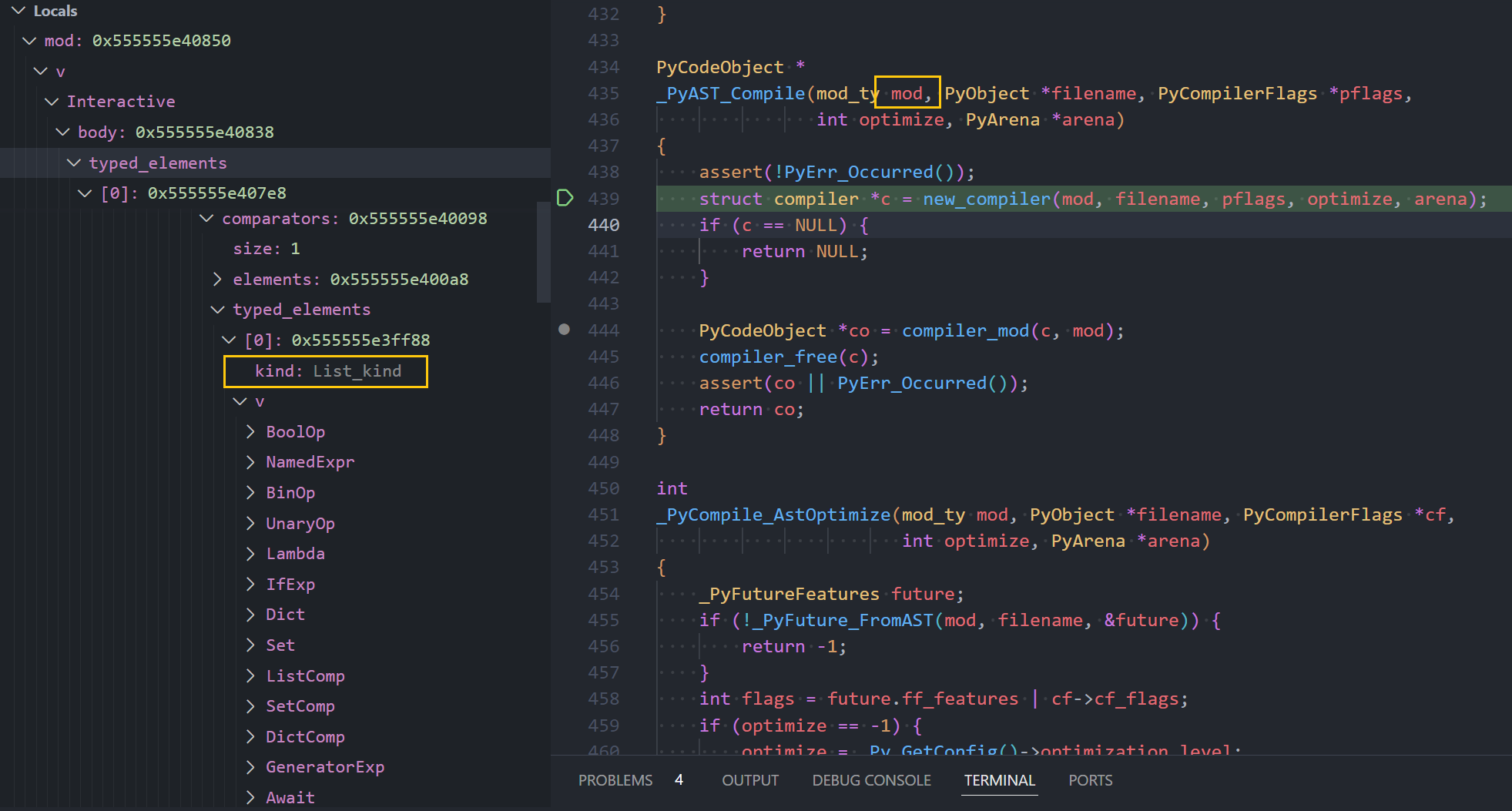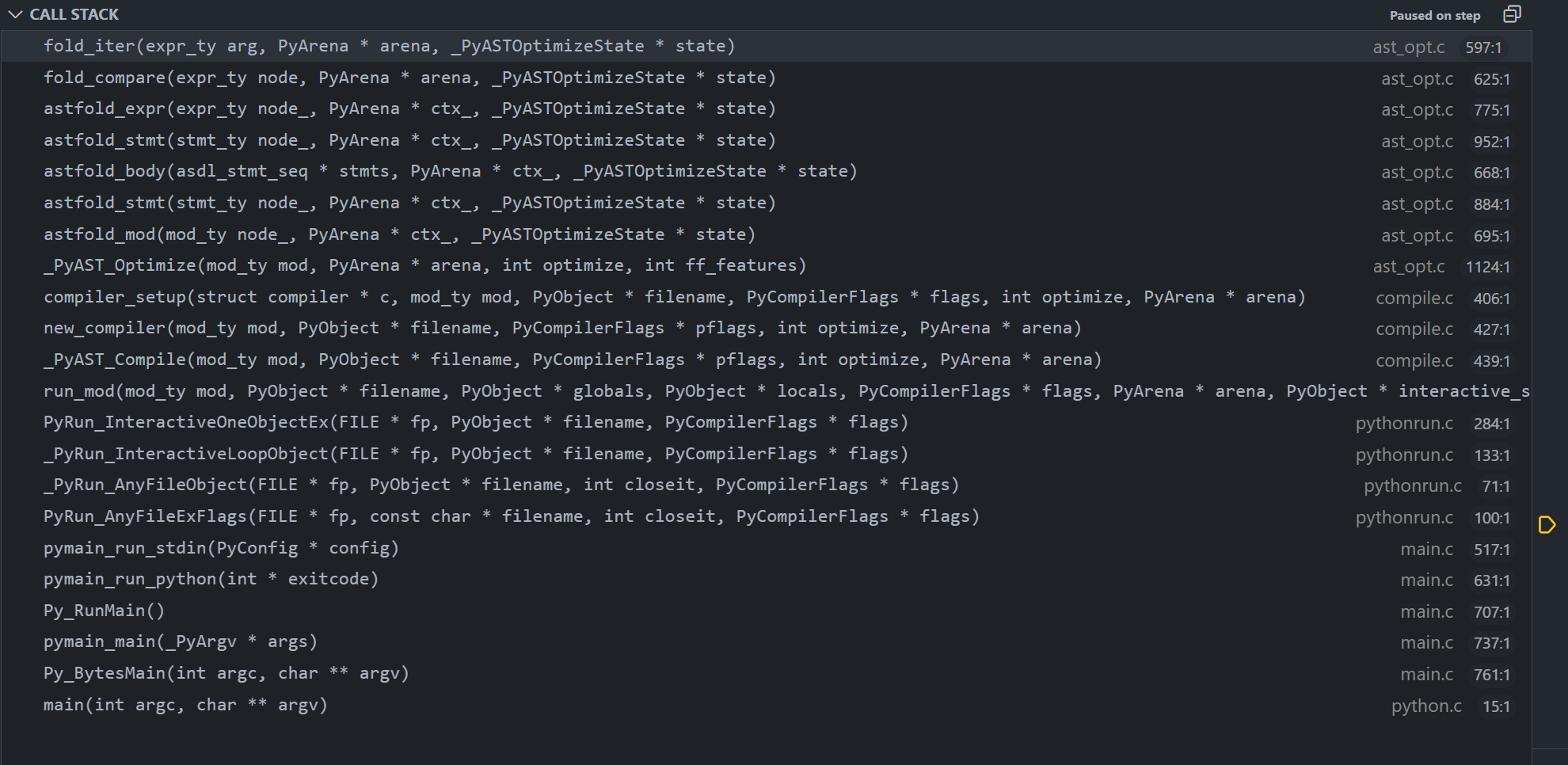Python 的 if in 结构对列表的优化
这一篇文章讨论一下 cpython 的实现中对于 if obj in [x, y, z, ..] 这种结构的优化。
首先看下面的三个函数。
>>> def f1():
... if 1 in (1,2,3):
... pass
...
>>> def f2():
... if 1 in [1,2,3]:
... pass
...
>>> def f3():
... a = [1,2,3]
... if 1 in a:
... pass
这是它们对应的字节码。
>>> dis(f1)
2 0 LOAD_CONST 1 (1)
2 LOAD_CONST 2 ((1, 2, 3))
4 CONTAINS_OP 0
6 POP_JUMP_IF_FALSE 7 (to 14)
3 8 NOP
10 LOAD_CONST 0 (None)
12 RETURN_VALUE
2 >> 14 LOAD_CONST 0 (None)
16 RETURN_VALUE
>>>
>>> dis(f2)
2 0 LOAD_CONST 1 (1)
2 LOAD_CONST 2 ((1, 2, 3))
4 CONTAINS_OP 0
6 POP_JUMP_IF_FALSE 7 (to 14)
3 8 NOP
10 LOAD_CONST 0 (None)
12 RETURN_VALUE
2 >> 14 LOAD_CONST 0 (None)
16 RETURN_VALUE
>>>
>>> dis(f3)
2 0 BUILD_LIST 0
2 LOAD_CONST 1 ((1, 2, 3))
4 LIST_EXTEND 1
6 STORE_FAST 0 (a)
3 8 LOAD_CONST 2 (1)
10 LOAD_FAST 0 (a)
12 CONTAINS_OP 0
14 POP_JUMP_IF_FALSE 11 (to 22)
4 16 NOP
18 LOAD_CONST 0 (None)
20 RETURN_VALUE
3 >> 22 LOAD_CONST 0 (None)
24 RETURN_VALUE
从字节码中可以很清晰的看到函数 f1 和函数 f2 的字节码完全一样。
f1 中使用字节码 LOAD_CONST 加载源码中的 (1, 2, 3),
f2 中同样使用字节码 LOAD_CONST 加载源码中的 [1, 2, 3]。
因为 Python 中 List 构造要比 Tuple 的构造更加复杂,所以这里
可以认为是 cpython 将 f2 中的 [1, 2, 3] 优化为了 (1, 2, 3)。
也将以将函数 f2 与 f3 的字节码进行比较,f3 中的字节码比较循规蹈矩,
先是构造一个空 List,然后构造一个 Tuple (1, 2, 3),再利用这个 Tuple
将 List 拓展成 List [1, 2, 3]。
看到这里我们可以理解 cpython 对 if .. in [..] 的优化应该是处于性能的考虑,
毕竟对于大多数 cpython 程序来说,重新编译字节码的次数要远小于这行字节码运行的次数。
我想探究的问题是这个优化发生于 cpython 编译字节码的什么具体哪个步骤中。在 cpython 中,
源代码到字节码的流程大致有如下步骤:
- 源代码解析成 Token,也称为词法分析。
- 将 Token 构造成一个 AST,称为语法分析。
- AST 优化。
- AST 编译为字节码。
可以做出合理猜测,上面的优化发生在第三个步骤——AST 优化中。接下来就是验证这个猜测的过程。 有了大致的方向,需要梳理一下验证工作的步骤。这里我的步骤如下:
- 找到步骤四的开始代码,验证 AST 的结构是否是已经被优化过的。 如果是,则优化发生在前三步, 否则是由步骤四的字节码生成器完成的。
- 找到步骤三的开始代码,验证 AST 的结构是否未被优化。 如果是,则优化发生后在第三步,否则发生在前两步。
如果对 cpython 比较熟悉,可以快速找到 编译 AST 到字节码的位置。
PyCodeObject *
_PyAST_Compile(mod_ty mod, PyObject *filename, PyCompilerFlags *pflags,
int optimize, PyArena *arena)
{
assert(!PyErr_Occurred());
struct compiler *c = new_compiler(mod, filename, pflags, optimize, arena);
if (c == NULL) {
return NULL;
}
PyCodeObject *co = compiler_mod(c, mod);
compiler_free(c);
assert(co || PyErr_Occurred());
return co;
}
参数 mod 就是步骤二生成的 AST。上面代码中两个函数调用比较重要, new_compiler 负责优化 AST,
compiler_mod 负责将 AST 编译为字节码。按照验证猜想的步骤,可以在这两个函数的前面分别打上断点,
看一下对应的 AST。这里插入一个小知识:使用 cpython 3.13 之前的标准库的 ast 模块获得的 AST 是没有被优化的,具体看文章中后面的专题小节。
cpython 的 C 代码中我没有发现有提供打印 AST 的调试函数, 所以这里看 AST 的办法只能是通过 GDB 或者其他调试手段。
用 VSCode 会方便些,基本就是断点到对应位置,然后看结构了,之后看是否有空写一个 GDB 调试脚本,用类似 ast 模块的方式打印 AST。

调试这个函数之后,可以发现调用 new_compiler 前后对应的节点从 List_kind 变为了 Tuple_kind。
接着调试 new_compiler 函数内部,可以追踪到 fold_compare 函数,里面的注释清晰的指明了这个优化。
而 List 变 Tuple 的过程则发生在 fold_iter 函数中。
static int
fold_compare(expr_ty node, PyArena *arena, _PyASTOptimizeState *state)
{
asdl_int_seq *ops;
asdl_expr_seq *args;
Py_ssize_t i;
ops = node->v.Compare.ops;
args = node->v.Compare.comparators;
/* Change literal list or set in 'in' or 'not in' into
tuple or frozenset respectively. */
i = asdl_seq_LEN(ops) - 1;
int op = asdl_seq_GET(ops, i);
if (op == In || op == NotIn) {
if (!fold_iter((expr_ty)asdl_seq_GET(args, i), arena, state)) {
return 0;
}
}
return 1;
}
static int
fold_iter(expr_ty arg, PyArena *arena, _PyASTOptimizeState *state)
{
PyObject *newval;
if (arg->kind == List_kind) {
/* First change a list into tuple. */
asdl_expr_seq *elts = arg->v.List.elts;
if (has_starred(elts)) {
return 1;
}
expr_context_ty ctx = arg->v.List.ctx;
arg->kind = Tuple_kind;
arg->v.Tuple.elts = elts;
arg->v.Tuple.ctx = ctx;
/* Try to create a constant tuple. */
newval = make_const_tuple(elts);
}
else if (arg->kind == Set_kind) {
newval = make_const_tuple(arg->v.Set.elts);
if (newval) {
Py_SETREF(newval, PyFrozenSet_New(newval));
}
}
else {
return 1;
}
return make_const(arg, newval, arena);
}
完整的堆栈图如下,调试使用的 cpython 代码版本为 3.13.0a6+ heads/main:b6c62c79e7

打印代码的 AST
在 cpython 3.13 之前,使用标准库的 ast 模块获得的 AST 是没有被优化的。可以看这个代码例子。
import ast
import inspect
def f():
if 5 in[1,2,3]:
pass
code = inspect.getsource(f)
tree = ast.parse(code)
print(ast.dump(tree, indent=4))
这段代码的输出如下,可以看到 List 并未被优化为 Tuple。
Module(
body=[
FunctionDef(
name='f',
args=arguments(
posonlyargs=[],
args=[],
kwonlyargs=[],
kw_defaults=[],
defaults=[]),
body=[
If(
test=Compare(
left=Constant(value=5),
ops=[
In()],
comparators=[
List(
elts=[
Constant(value=1),
Constant(value=2),
Constant(value=3)],
ctx=Load())]),
body=[
Pass()],
orelse=[])],
decorator_list=[])],
type_ignores=[])
在 cpython 3.13 之后,ast 模块的 ast.parse 函数增加了一个 optimize 参数,设置为大于 0 的值可以获取优化后的 AST。
def parse(source, filename='<unknown>', mode='exec', *,
type_comments=False, feature_version=None, optimize=-1):
"""
Parse the source into an AST node.
Equivalent to compile(source, filename, mode, PyCF_ONLY_AST).
Pass type_comments=True to get back type comments where the syntax allows.
"""
flags = PyCF_ONLY_AST
if optimize > 0:
flags |= PyCF_OPTIMIZED_AST
if type_comments:
flags |= PyCF_TYPE_COMMENTS
if feature_version is None:
feature_version = -1
elif isinstance(feature_version, tuple):
major, minor = feature_version # Should be a 2-tuple.
if major != 3:
raise ValueError(f"Unsupported major version: {major}")
feature_version = minor
# Else it should be an int giving the minor version for 3.x.
return compile(source, filename, mode, flags,
_feature_version=feature_version, optimize=optimize)
仍然使用上面的代码,看一下优化后的 AST 如何。
import ast
import inspect
def f():
if 5 in[1,2,3]:
pass
code = inspect.getsource(f)
tree = ast.parse(code, optimize=1)
print(ast.dump(tree, indent=4))
输出中可以看到 List 被优化成了 Constant:
Module(
body=[
FunctionDef(
name='f',
args=arguments(
posonlyargs=[],
args=[],
kwonlyargs=[],
kw_defaults=[],
defaults=[]),
body=[
If(
test=Compare(
left=Constant(value=5),
ops=[
In()],
comparators=[
Constant(value=(1, 2, 3))]),
body=[
Pass()],
orelse=[])],
decorator_list=[],
type_params=[])],
type_ignores=[])
Home Page